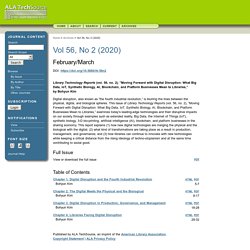

Vol 56, No 2 (2020) Library Technology Reports (vol. 56, no. 2), “Moving Forward with Digital Disruption: What Big Data, IoT, Synthetic Biology, AI, Blockchain, and Platform Businesses Mean to Libraries,” by Bohyun Kim Digital disruption, also known as “the fourth industrial revolution,” is blurring the lines between the physical, digital, and biological spheres.

This issue of Library Technology Reports (vol. 56, no. 2), “Moving Forward with Digital Disruption: What Big Data, IoT, Synthetic Biology, AI, Blockchain, and Platform Businesses Mean to Libraries,” examines today’s leading-edge technologies and their disruptive impacts on our society through examples such as extended reality, Big Data, the Internet of Things (IoT), synthetic biology, 3-D bio-printing, artificial intelligence (AI), blockchain, and platform businesses in the sharing economy. Exploring the impact of Artificial Intelligence and robots on higher education through literature-based design fictions. Amer, M., Daim, T., & Jetter, A. (2013).

A review of scenario planning. Futures, 46, 23–40.Article Google Scholar Atanassova, I., Bertin, M., & Mayr, P. (2019). Editorial: mining scientific papers: NLP-enhanced bibliometrics. Frontiers in Research Metrics and Analytics. Five ways to make AI a greater force for good in 2021. It’s not that large-scale models could never reach common-sense understanding.

That’s still an open question. But there are other avenues of research deserving greater investment. Some experts have placed their bets on neurosymbolic AI, which combines deep learning with symbolic knowledge systems. Others are experimenting with more probabilistic techniques that use far less data, inspired by a human child’s ability to learn from very few examples. In 2021, I hope the field will realign its incentives to prioritize comprehension over prediction. Empower marginalized researchers If algorithms codify the values and perspectives of their creators, a broad cross-section of humanity should be present at the table when they are developed.
At the time I lauded the community for its progress. Center the perspectives of impacted communities There’s also another group to bring to the table. My hope for 2021 is to see more of these ideas explored and adopted in earnest. The true dangers of AI are closer than we think. William Isaac is a senior research scientist on the ethics and society team at DeepMind, an AI startup that Google acquired in 2014.

He also cochairs the Fairness, Accountability, and Transparency conference—the premier annual gathering of AI experts, social scientists, and lawyers working in this area. I asked him about the current and potential challenges facing AI development—as well as the solutions. Q: Should we be worried about superintelligent AI? A: I want to shift the question. The threats overlap, whether it’s predictive policing and risk assessment in the near term, or more scaled and advanced systems in the longer term. There are three areas that I want to flag. The second one would be achieving demonstrable social benefit. Lastly, I think the biggest one that anyone who works in the space is concerned about is: what are the robust mechanisms of oversight and accountability. Q: How do we overcome these risks and challenges? A: Three areas would go a long way.
AI Readiness Webinars for Educators. AI for Educators Here you can find recordings of the webinars for educators as they went out live during May to September 2020.

If you would like to view the introduction to the series for the AI-Curious, you can go back and view it, and the ETHICAL AI Framework the series is built around, here. Step 1 - Educate, enthuse, excite This webinar is about building an AI mindset within your community. "If AI is able to bring together the different data sources, it would free up teachers to do what they came into the profession to do. " With Rose and special guest Karine George. Step 2 - Tailor and Hone This webinar is about examining the challenges you want to address with data and AI. "Deciding which challenges to examine with AI is actually a 2-part question.
Step 3 - Identify This webinar is about identifying and collating existing data sources. "Frequently, what we're collecting data from is just a proxy for what we actually intend to understand and support in education. " AI in Education: Michaelmas term events. Future of AI and education v5 WEB.